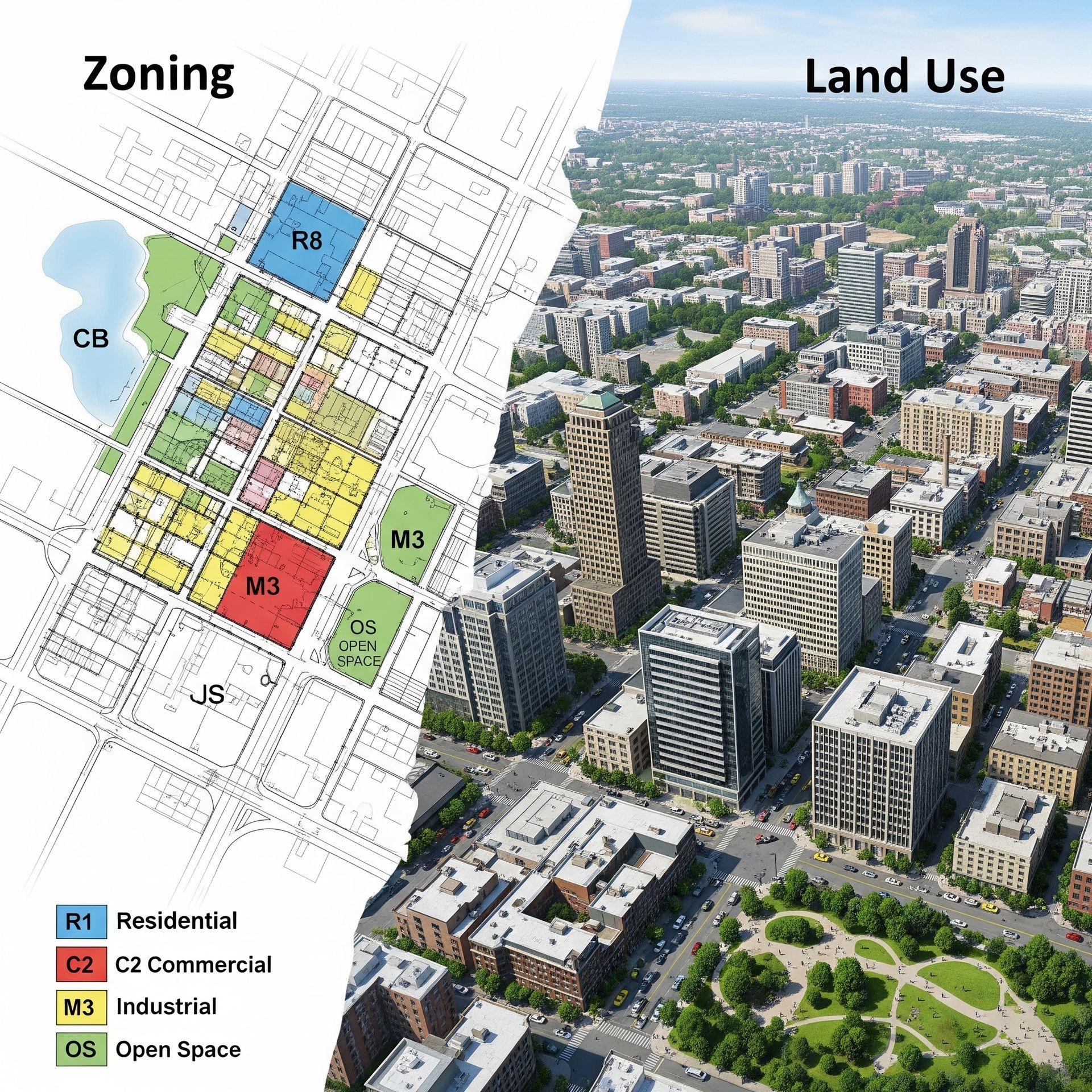What Developers Often Overlook About Public Hearings
Public hearings represent a critical juncture in the development process, yet many developers approach them with inadequate preparation. Successful land development requires more than presenting blueprints—it demands building genuine trust, actively listening to concerns, and communicating clearly without technical jargon. When developers master these elements and understand local regulations thoroughly, they can transform skeptical neighbors into project supporters.
Key Takeaways
- Early engagement matters: Inclusive community engagement builds trust and reduces opposition before formal hearings
- Regulatory knowledge is essential: Understanding local zoning and land use rules aligns projects with community standards
- Presentation quality impacts outcomes: Clear, well-organized materials improve communication and participation
- Proactive concern management: Anticipating common concerns like traffic and noise builds trust and support
- Procedural understanding: Knowing hearing procedures maintains respectful dialogue and credibility
The Importance of Early Community Engagement
Starting community conversations before finalizing development plans prevents significant obstacles during formal public hearings. While jumping directly into architectural work may seem efficient, early community involvement typically saves time, resources, and relationships in the long term.
Building Trust Through Inclusive Dialogue
When developers initiate inclusive dialogue from the project's beginning, they establish community trust rather than merely checking procedural boxes. Residents want to feel heard and valued, particularly when proposed changes may affect their daily lives and neighborhood character.
This approach resembles inviting neighbors to collaborate on shared goals rather than surprising them with completed plans. Although early engagement requires additional time investment, this effort typically converts skeptics into supporters and substantially reduces opposition during official hearings. Community members often provide valuable insights about local patterns, historical context, and practical considerations that improve project design—perspectives that professional consultants may miss despite their technical expertise.
Beyond the immediate project benefits, early engagement establishes a developer's reputation within the community. When neighbors see that you've consistently listened to feedback and made meaningful adjustments based on their input, they're more likely to trust future proposals. This credibility becomes particularly valuable in jurisdictions where developers work on multiple projects over time, as positive experiences with one development create goodwill that carries forward to subsequent ventures.
Consider establishing a community advisory committee for larger projects, providing regular project updates through newsletters or dedicated websites, and hosting informal coffee chats before formal hearings. These touchpoints create multiple opportunities for dialogue and help identify potential issues early when they're easier to address through design modifications rather than costly revisions after plans are finalized.
Understanding Local Zoning and Land Use Regulations
After establishing initial community dialogue, developers must thoroughly understand the regulatory framework governing what can actually be built. Local zoning classifications function as a neighborhood's blueprint, specifying which building types and uses are appropriate for different areas.
Land use compatibility ensures that proposed projects harmonize with surrounding properties and community character. This concept extends beyond simple regulatory compliance—it reflects respect for the neighborhood's rhythm and existing fabric. When developers demonstrate a thorough understanding of these rules, they encounter fewer surprises during public hearings and receive more support from neighbors.
Additionally, staying informed about upcoming zoning changes or comprehensive plan updates can provide strategic advantages. Many municipalities regularly review and update their land use regulations to reflect evolving community priorities, and developers who participate in these planning processes gain valuable insights into future regulatory directions. This forward-looking approach helps developers align their projects with community goals before formal applications are submitted.
Essential Regulatory Elements
| Component | Purpose | Development Impact |
|---|---|---|
| Zoning Districts | Define permitted uses and density | Determines project feasibility |
| Setback Requirements | Establish building placement | Affects site design |
| Height Restrictions | Limit vertical development | Influences building massing |
| Parking Standards | Specify required parking | Impacts site layout and costs |
Preparing Comprehensive and Clear Presentation Materials
Presentation quality directly influences how community members understand and respond to development proposals. Well-prepared materials facilitate understanding and demonstrate respect for participants' time and intelligence.
Effective Communication Strategies
Focus on concise messaging: delivering key points sharply without overwhelming audiences with excessive detail or technical terminology. Visual aids serve as powerful tools: simple charts, maps, site plans, and architectural renderings help audiences grasp concepts more effectively than words alone.
Structure presentation materials logically so that information flows smoothly:
- Project overview: Brief description of development goals and community benefits
- Site context: Current conditions and surrounding neighborhood character
- Design approach: How the project responds to community feedback
- Impact analysis: Traffic, environmental, and infrastructure considerations
- Mitigation measures: Specific steps to address identified concerns
When presentations feel clear and inviting rather than defensive, community members are more likely to listen attentively and potentially support the project.
Remember that accessibility matters in presentation materials as well. Consider providing materials in multiple languages if your community includes non-English speakers, ensuring font sizes are readable, and making digital versions available online before the hearing. These considerations demonstrate inclusivity and allow community members adequate time to review complex information before they need to form opinions or provide testimony.
Anticipating and Addressing Community Concerns
Proactive identification and thoughtful response to community concerns distinguish successful developers from those who struggle through contentious hearings.
Common Community Issues
Understanding typical concerns allows developers to prepare thorough responses before questions arise:
- Traffic and transportation: Increased vehicle trips, parking spillover, and pedestrian safety
- Noise and activity: Construction disturbance and operational noise levels
- Visual character: Building scale, architectural style, and neighborhood compatibility
- Environmental impacts: Tree removal, stormwater management, and green space
- Public services: Strain on schools, utilities, and infrastructure capacity
When developers demonstrate genuine care through meaningful community engagement, public perception shifts favorably. Community members want to feel safe, valued, and confident that their voices matter in decisions affecting their neighborhood.
Proactive Concern Mitigation
Address concerns before they escalate during public hearings through several key strategies:
- Early outreach: Share project plans through multiple channels—neighborhood meetings, website updates, and direct outreach to nearby property owners. This prevents community members from feeling surprised or excluded.
- Concern assessment: Systematically identify which issues matter most to the community through surveys and informal conversations. Pay particular attention to concerns raised during early engagement, as these often signal broader community sentiment that will emerge during formal hearings.
- Transparent problem-solving: Address identified concerns with specific mitigation measures. For example, if traffic is a concern, present actual traffic studies and proposed improvements rather than vague assurances. If residents worry about building height, show sight line studies demonstrating how the structure relates to existing buildings.
- Documentation and follow-through: Keep detailed records of community concerns raised and how your project responds to each issue. This documentation demonstrates good faith engagement and provides valuable material for hearing presentations. When you've made project changes based on community input, explicitly highlight these modifications to show that participation produces real results.
This approach transforms public hearings from confrontational events into collaborative problem-solving sessions where community members feel their voices have shaped project outcomes.
The Role of Public Hearing Procedures and Protocols
Understanding how public hearings operate helps developers navigate these forums effectively while respecting processes designed to ensure fair community participation.
Understanding Hearing Formats
Public hearings follow specific formats that vary depending on jurisdiction and project type. Common formats include formal city council meetings, planning commission sessions, and less structured community forums. Each has distinct characteristics—some require speaking from a podium during designated time slots, while others allow more flexible dialogue.
Understanding these procedural details helps you participate effectively and respectfully. Proper notification ensures all stakeholders receive adequate opportunity to learn about proposals and prepare meaningful input.
Rules Governing Public Input
| Rule Category | Purpose |
|---|---|
| Time Limits (2-5 minutes) | Ensures all interested parties can speak |
| Speaker Order | Provides fair access without favoring viewpoints |
| Topic Relevance | Maintains focus on relevant decision-making criteria |
| Respectful Conduct | Preserves constructive dialogue and safe participation |
Following these protocols demonstrates respect for the public process and helps developers contribute effectively without creating unnecessary conflict.
Building Relationships With Local Officials and Stakeholders
Strong relationships with decision-makers and community leaders represent essential assets for navigating the development approval process successfully.
Effective Stakeholder Engagement
Meaningful stakeholder engagement means listening carefully, sharing information transparently, and demonstrating through actions that you genuinely value community input:
- Regular communication: Maintain ongoing dialogue rather than appearing only for formal procedures
- Accessible information: Provide clear, jargon-free explanations through multiple formats
- Responsive feedback: Show how community input influences project decisions
- Inclusive participation: Engage diverse community voices, including underrepresented groups
When people feel genuinely included in neighborhood conversations, they're more likely to support development efforts. This transforms public hearings from adversarial confrontations into collaborative problem-solving sessions.
Strategies for Responding to Opposition and Feedback
Even with excellent preparation, developers will inevitably face opposition and receive critical feedback. How you respond to criticism often matters more than the criticism itself.
Effective Response Strategies
Effective opposition strategies begin with careful listening, maintaining composure, and demonstrating respect for concerns even when you disagree. Active listening means truly hearing what's being said rather than merely waiting for your turn to respond.
Establish multiple channels for gathering feedback: surveys, comment cards, dedicated email addresses, and follow-up meetings. Address concerns honestly and specifically rather than offering vague reassurances. No one expects perfection, but everyone appreciates sincere effort and genuine responsiveness.
Embrace feedback as an opportunity to learn and improve project design. This approach transforms critics into collaborators and creates stronger projects that better serve both development objectives and community needs.
Frequently Asked Questions
How do public hearings affect project financing and investment?
Public hearings significantly impact financing through their influence on approval timelines and project scope, as lenders and investors monitor community feedback for risks of delays or costly modifications. Developers should include meaningful stakeholder engagement in their investment strategies to maintain investor confidence throughout the approval process.
What technology tools can improve virtual public hearing participation?
Virtual engagement platforms with features like live streaming, real-time commenting, interactive maps, and translation services expand participation beyond traditional in-person hearings, particularly for community members with mobility limitations or schedule conflicts. These technologies produce more representative input and stronger community buy-in for development projects.
Are public hearings legally required for all development projects?
Public hearing requirements vary based on project type, size, and location—generally, projects requiring rezoning, conditional use permits, or variances necessitate hearings, while smaller projects under existing zoning may only need administrative review. Developers should consult local planning departments early to understand specific legal requirements in their jurisdiction.
How do public hearings influence environmental impact assessments?
Public hearings help shape environmental assessments by providing opportunities for community members to identify concerns that technical consultants might overlook, such as local wildlife patterns or historical flooding areas. This stakeholder engagement creates more comprehensive analyses and projects with better environmental performance and community acceptance.
What are common mistakes developers make after public hearings conclude?
Many developers mistakenly treat hearing conclusion as the end of community engagement rather than maintaining ongoing communication about construction schedules and addressing concerns promptly. Sustained engagement builds lasting trust and establishes positive reputations that benefit future projects.
Final Thoughts
Public hearings represent far more than procedural requirements—they're critical opportunities to build community trust, refine project design, and establish successful development outcomes. Developers who skip early community conversations, provide unclear information, or fail to build genuine relationships often face unexpected delays or project denial.
Success requires listening attentively to diverse perspectives and preparing to respond constructively to feedback. With thoughtful preparation, genuine engagement, and respectful dialogue, developers can convert potential obstacles into opportunities that benefit both projects and communities. The investment in effective public hearing participation consistently proves worthwhile through smoother approvals, stronger projects, and lasting community partnerships.
Navigate zoning and development challenges with confidence. Connect with Beacon Land now.
References:
http://www.na-businesspress.com/JSIS/JSIS15-1/3_DriskillD_15_1_.pdf
https://www.houstontx.gov/council/meetingsinfo.html


